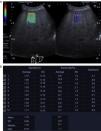Liver elastography is a noninvasive method for diagnosing fibrosis that has been developed over the last decade in response to the limitations of liver biopsies, blood markers, and traditional imaging modalities. There are different methods of measuring tissue stiffness through ultrasound; thus far, shear wave elastography has proven superior for diagnosing clinically significant liver fibrosis, where early detection modifies the approach to treatment and improves prognosis.
This article aims to provide a brief review of the different methods for performing elastography with ultrasound, focusing especially on shear wave elastography and on technical aspects for carrying out the procedure and key points for interpreting the findings.
La elastografía hepática representa un método no invasivo de uso actual para el diagnóstico de fibrosis desarrollado a partir de las limitaciones encontradas con la biopsia hepática, los marcadores serológicos y las modalidades de imagen tradicionales durante la última década. Existen diferentes métodos de elastografía por ultrasonido, de los cuales hasta el momento la elastografía por ondas de choque ha demostrado superioridad para el diagnóstico de fibrosis clínicamente significativa, en la que la detección temprana de la enfermedad modifica el tratamiento y mejora el pronóstico. Se pretende realizar una corta revisión de los diferentes métodos de elastografía mediante ultrasonido, haciendo énfasis en la elastografía por ondas de choque, así como los aspectos técnicos para su realización y los puntos clave para su interpretación.











